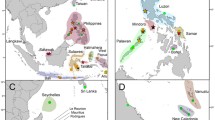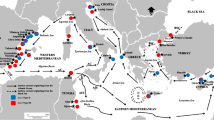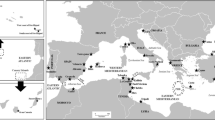Abstract
The South Pacific is a biodiverse region of extreme evolutionary importance because it harbors ancient lineages and recent radiations. However, few population-level studies of genetic variation have been conducted in the land masses of this region. Likewise, the number of population-level studies using myriapods as models is extremely small. In this article, we compare the genetic structure of two species of centipedes in the genus Cryptops endemic to the South Pacific, one from a continental island, the other from oceanic islands. The level of genetic diversity and structure in C. pictus, a species endemic to New Caledonia, is much higher than in C. niuensis in Fiji and Vanuatu, despite the fact that C. niuensis is spread across two different archipelagos and several islands. The most likely explanation is the relatively young age of the remnants of the Vitiaz Arc (Fiji and Vanuatu) compared to New Caledonia. Using the emergence of Fiji-Vanuatu as a calibration point, C. pictus is estimated to have diverged by 23.4 Mya (upper 95% confidence interval) with a mean estimate of 11.7 Mya versus the 9.7 Mya of C. niuensis. Considering the absence of shared sequences between specimens from different sampling sites and the high genetic structuring within populations, C. pictus appears to be an ideal candidate to assess historical processes at a micro-evolutionary scale in New Caledonia.





Similar content being viewed by others
References
Balke, M., Pons, J., Ribera, I., Sagata, K., & Vogler, A. P. (2007). Infrequent and unidirectional colonization of hyperdiverse Papuadytes diving beetles in New Caledonia and New Guinea. Molecular Phylogenetics and Evolution, 42, 505–516.
Balke, M., Wewalka, G., Alarie, Y., & Ribera, I. (2007). Molecular phylogeny of Pacific island Colymbetinae: radiation of New Caledonian and Fijian species (Coleoptera, Dytiscidae). Zoologica Scripta, 36, 173–200.
Bouchet, P., Le Guyader, H., & Pascal, O. (2009). The SANTO 2006 Global Biodiversity Survey: an attempt to reconcile the pace of taxonomy and conservation. Zoosystema, 31, 401–406.
Boyer, S. L., Clouse, R. M., Benavides, L. R., Sharma, P., Schwendinger, J., Karunarathna, I., et al. (2007). Biogeography of the world, a case study from cyphophthalmid Opiliones, a globally distributed group of arachnids. Journal of Biogeography, 34, 2070–2085.
Bryant, D., & Moulton, V. (2004). Neighbor-net: and agglomerative method for the construction of phylogenetic networks. Molecular Biology and Evolution, 21, 255–265.
Clark, J. R., Wagner, W. L., & Roalson, E. H. (2009). Patterns of diversification and ancestral range reconstruction in the southeast Asian-Pacific angiosperm lineage Cyrtandra (Gesneriaceae). Molecular Phylogenetics and Evolution, 53, 982–994.
Clegg, S. M., & Phillimore, A. B. (2010). The influence of gene flow and drift on genetic and phenotypic divergence in two species of Zosterops in Vanuatu. Philosophical Transactions of the Royal Society/B, 365, 1077–1092.
Colley, H. (2009). Fiji, geology. In D. A. Clague & R. G. Gillespie (Eds.), Encyclopedia of islands (pp. 305–309). Berkeley: University of California Press.
Crawford, A. J., Meffre, S., & Symonds, P. A. (2003). 120 to 0 Ma tectonic evolution of the southwest Pacific and analogous geological evolution of the 600 to 220 Ma Tasman Fold Belt System. Geological Society of Australia. Special Publication, 22, 377–397.
Dress, A., Huson, D., & Moulton, V. (1996). Analyzing and visualizing sequence and distance data using SplitsTree. Discrete Applied Mathematics, 71, 95–109.
Drummond, A. J., Ho, S. Y. W., Phillips, M. J., & Rambaut, A. (2006). Relaxed phylogenetics and dating with confidence. PLoS Biology, 4, e88.
Drummond, A. J., & Rambaut, A. (2007). BEAST: Bayesian evolutionary analysis by sampling trees. BMC Evolutionary Biology, 7, 214.
Edgar, R. C. (2004). MUSCLE: a multiple sequence alignment with high accuracy and high throughput. Nucleic Acids Research, 32, 1792–1797.
Edgecombe, G. D., & Giribet, G. (2008). A New Zealand species of the trans-Tasman centipede order Craterostigmomorpha (Arthropoda: Chilopoda) corroborated by molecular evidence. Invertebrate Systematics, 22, 1–15.
Edgecombe, G. D., & Giribet, G. (2009). Phylogenetics of scutigeromorph centipedes (Myriapoda: Chilopoda) with implications for species delimitation and historical biogeography of the Australian and New Caledonian faunas. Cladistics, 25, 406–427.
Evenhuis, N. L., & Bickel, D. J. (2009). Indexes to Fiji arthropods (volumes 1–15) [2005–2009]. In N. L. Evenhuis, & D. J. Bickel (Eds.), Fiji arthropods XV (pp. 43–58). Bishop Museum Occasional Papers, 106.
Falvey, D. A., Colwell, J. B., Coleman, P. J., Greene, H. G., Vedder, J. G., & Burns, T. R. (1991). Petroleum prospectivity of Pacific island arcs: Solomon Islands and Vanuatu. APEA Journal, 31, 191–205.
Folmer, O., Black, M., Hoeh, W., Lutz, R., & Vrijenhoek, R. C. (1994). DNA primers for amplification of mitochondrial cytochrome c oxidase subunit I from diverse metazoan invertebrates. Molecular Marine Biology and Biotechnology, 3, 294–299.
Garb, J. E., & Gillespie, R. G. (2006). Island hopping across the central Pacific: mitochondrial DNA detects sequential colonization of the Austral Islands by crab spiders (Araneae: Thomisidae). Journal of Biogeography, 33, 201–220.
Giribet, G., Guzmán Cuéllar, A., & Edgecombe, G. D. (2009). Further use of molecular data in studying biogeographic patterns within the centipede genus Craterostigmus: the case for a monophyletic New Zealand species. Soil Organisms, 81, 557–563.
Giribet, G., Vogt, L., Pérez-González, A., Sharma, P., & Kury, A. B. (2010). A multilocus approach to harvestman (Arachnida: Opiliones) phylogeny with emphasis on biogeography and the systematics of Laniatores. Cladistics, 26, 408–437.
Grandcolas, P., Murienne, J., Robillard, T., Desutter-Grandcolas, L., Jourdan, H., Guilbert, E., et al. (2008). New Caledonia: a very old Darwinian island? Philosophical Transactions of the Royal Society/B, 363, 3309–3317.
Hall, R. (2002). Cenozoic geological and plate tectonic evolution of SE Asia and the SW Pacific: computer-based reconstructions, model and animations. Journal of Asian Earth Sciences, 20, 353–431.
Hamilton, A. M., Hartman, J. H., & Austin, C. C. (2009). Island area and species diversity in the southwest Pacific Ocean: is the lizard fauna of Vanuatu depauperate? Ecography, 32, 247–258.
Heads, M. (2010). Biogeographical affinities of the New Caledonian biota: a puzzle with 24 pieces. Journal of Biogeography, 37, 1179–1201.
Ho, S. Y. W., & Phillips, M. (2009). Accounting for calibration uncertainty in phylogenetic estimation of evolutionary divergence times. Systematic Biology, 58, 367–380.
Holsinger, K. E., & Weir, B. S. (2009). Genetics in geographically structured populations: defining, estimating and interpreting F ST. Nature Reviews. Genetics, 10, 639–646.
Huson, D. H., & Bryant, D. (2006). Application of phylogenetic networks in evolutionary studies. Molecular Biology and Evolution, 23, 254–267.
Jolivet, P., & Verma, K. K. (2010). Good morning Gondwana. Annales de la Société Entomologique de France, 46, 53–61.
Keogh, J. S., Edwards, D. L., Fisher, R. N., & Harlow, P. S. (2008). Molecular and morphological analysis of the critically endangered Fijian iguanas reveals cryptic diversity and a complex biogeographic history. Philosophical Transactions of the Royal Society/B, 363, 3413–3426.
Keppel, G., Lowe, A., & Possingham, H. P. (2009). Changing perspectives on the biogeography of the tropical South Pacific: influences of dispersal, vicariance and extinction. Journal of Biogeography, 36, 1035–1054.
Kimura, M. (1980). A simple method for estimating evolutionary rate of base substitutions through comparative studies of nucleotide sequences. Journal of Molecular Evolution, 16, 11–120.
Kirchman, J. J., & Franklin, J. D. (2007). Comparative phylogeography and genetic structure of Vanuatu birds: Control region variation in a rail, a dove, and a passerine. Molecular Phylogenetics and Evolution, 43, 14–23.
Kurata, K., Jaffré, T., & Setoguchi, H. (2008). Genetic diversity and geographical structure of the pitcher plant Nepenthes vieillardii in New Caledonia: a chloroplast DNA haplotype analysis. American Journal of Botany, 95, 1632–1644.
Librado, P., & Rozas, J. (2009). DnaSP v5: a software for comprehensive analysis of DNA polymorphism data. Bioinformatics, 25, 1451–1452.
Lucky, A., & Sarnat, E. M. (2010). Biogeography and diversification of the Pacific ant genus Lordomyrma Emery. Journal of Biogeography, 37, 624–634.
Marek, P. E., & Bond, J. E. (2009). A Müllerian mimicry ring in Appalachian millipedes. Proceedings of the National Academy of Sciences of the United States of America, 106, 9755–9760.
Monaghan, M. T., Balke, M., Pons, J., & Vogler, A. P. (2006). Complex DNA taxonomy of a South Pacific Island radiation. Proceedings of the Royal Society/B, 273, 887–893.
Morat, P., Veillon, J. M., & MacKee, H. S. (1986). Floristic relationships of New Caledonian rainforest phanerogams. Teleopea, 2, 631–679.
Mueller-Dombois, D., & Fosberg, F. R. (1998). Vegetation of the tropical Pacific islands. New York: Springer.
Murienne, J. (2009a). New Caledonia: biology. In R. G. Gillespie & D. Clague (Eds.), Encyclopedia of islands (pp. 643–645). Berkeley: University of California Press.
Murienne, J. (2009b). Testing biodiversity hypotheses in New Caledonia using phylogenetics. Journal of Biogeography, 36, 1433–1434.
Murienne, J. (2010). Panbiogeography of New Caledonia, a response to Heads (2008). Journal of Biogeography, 37, 1625–1626.
Murienne, J., Edgecombe, G. D., & Giribet, G. (2010). Including secondary structure, fossils and molecular dating in the centipede tree of life. Molecular Phylogenetics and Evolution, 57, 301–313.
Murienne, J., Grandcolas, P., Piulachs, M., Bellés, X., D’Haese, C., Legendre, F., et al. (2005). Evolution on a shaky piece of Gondwana: is local endemism recent in New Caledonia? Cladistics, 21, 2–7.
Murienne, J., Guilbert, E., & Grandcolas, P. (2009). Species’ diversity in the New Caledonian endemic genera Cephalidiosus and Nobarnus (Insecta: Heteroptera: Tingidae), an approach using phylogeny and species’ distribution modelling. Biological Journal of the Linnean Society, 97, 177–184.
Murienne, J., Karaman, I., & Giribet, G. (2010). Explosive evolution of an ancient group of Cyphophthalmi (Arachnida: Opiliones) in the Balkan Peninsula. Journal of Biogeography, 37, 90–102.
Murienne, J., Pellens, R., Budinoff, R. B., Wheeler, W. C., & Grandcolas, P. (2008). Phylogenetic analysis of the endemic New Caledonian cockroach Lauraesilpha. Testing competing hypotheses of diversification. Cladistics, 24, 802–812.
Murienne, J., Pellens, R., & Grandcolas, P. (2008b). Short-range endemism in New Caledonia. Distribution and new species in the genus Lauraesilpha. In P. Grandcolas (Ed.), Zoologia Neocaledonica 7 (pp. 261–271). Biodiversity Studies, 197.
Nunn, P. D. (2009). Vanished islands and hidden continents of the Pacific. Honolulu: University of Hawai’i Press.
Pelletier, B. (2006). Geology of the New Caledonia region and its implications for the study of the New Caledonian biodiversity. In C. Payri, & B. Richer de Forges (Eds.), Compendium of marine species from New Caledonia (pp. 19–32). Dossiers Scientifiques et Techniques, II7. Nouméa, New Caledonia: IRD.
Prendini, L., Weygoldt, P., & Wheeler, W. C. (2005). Systematics of the Damon variegatus group of African whip spiders (Chelicerata: Amblypygi): evidence from behaviour, morphology and DNA. Organisms Diversity & Evolution, 5, 203–236.
Rambaut, A., & Drummond, A. J. (2007). Tracer v1.5. Program available from http://beast.bio.ed.ac.uk/tracer. Accessed 1 February 2010.
Ribaut, H. (1923). Chilopodes de la Nouvelle-Calédonie et des Iles Loyalty. In F. Sarasin & J. Roux (Eds.), Nova Caledonia, Forschungen in Neu-Caledonien und auf den Loyalty-Inseln. Vol. 3 (pp. 1–79). Berlin: C. W. Kreidels Verlag.
Sanderson, M. J. (2002). Estimating absolute rates of molecular evolution and divergence times: a penalized likelihood approach. Molecular Biology and Evolution, 19, 101–109.
Sanderson, M. J. (2003). r8s: Inferring absolute rates of molecular evolution and divergence dates in the absence of a molecular clock. Bioinformatics, 19, 301–302.
Schmidt, H. A., Strimmer, K., Vingron, M., & Haeseler, A. von (2003). Tree-puzzle 5.3. Program available from http://www.tree-puzzle.de/. Accessed 1 February 2010.
Schmidt, H. A., Strimmer, K., Vingron, M., & von Haeseler, A. (2002). TREE-PUZZLE: maximum likelihood phylogenetic analysis using quartets and parallel computing. Bioinformatics, 18, 502–504.
Schwendinger, J., & Giribet, G. (2005). The systematics of the south-east Asian genus Fangensis Rambla (Opiliones: Cyphophthalmi: Stylocellidae). Invertebrate Systematics, 19, 297–323.
Smith, S. A. (2009). Taking into account phylogenetic and divergence-time uncertainty in a parametric biogeographical analysis of the northern hemisphere plant clade Caprifolieae. Journal of Biogeography, 36, 2324–2337.
Stamatakis, A. (2006). RAxML-VI-HPC: maximum likelihood-based phylogenetic analyses with thousands of taxa and mixed models. Bioinformatics, 22, 2688–2690.
Stamatakis, A., Hoover, P., & Rougemont, J. (2008). A rapid bootstrap algorithm for the RAxML web servers. Systematic Biology, 57, 758–771.
Stoev, P., Akkari, N., Zapparoli, M., Porco, M., Enghoff, H., Edgecombe, G. D., et al. (2010). The genus Eupolybothrus Verhoeff, 1907 (Chilopoda: Lithobiomorpha: Lithobiidae) in North Africa, a cybertaxonomic revision, with an interactive key to all species in the genus and the first use of DNA barcoding for the group. ZooKeys, 50, 29–77.
Strimmer, K., & von Haeseler, A. (1997). Likelihood-mapping: a simple method to visualize phylogenetic content of a sequence alignment. Proceedings of the National Academy of Sciences of the United States of America, 94, 6815–6819.
Tamura, K., Dudley, J., Nei, M., & Kumar, S. (2007). MEGA4: Molecular Evolutionary Genetics Analysis (MEGA) software version 4.0. Molecular Biology and Evolution, 24, 1596–1599.
Tamura, K., & Nei, M. (1993). Estimation of the number of nucleotide substitutions in the control region of mitochondrial DNA in humans and chimpanzees. Molecular Biology and Evolution, 10, 512–526.
Tamura, K., Nei, M., & Kumar, S. (2004). Prospects for inferring very large phylogenies by using the neighbor-joining method. Proceedings of the National Academy of Sciences of the United States of America, 101, 11030–11035.
Tappin, D. R., & Ballance, P. F. (1994). Contributions to the sedimentary geology of’Eua Island, Kingdom of Tonga; reworking in an oceanic forearc. In A. J. Stevenson, R. H. Herzer, & P. F. Ballance (Eds.), Geology and submarine resources of the Tonga-Lau-Fiji region (pp. 1–20). SOPAC Technical Bulletin, 8. Suva, Fiji: SOPAC Secretariat.
van Balgooy, M. M. J. (1971). Plant-geography of the Pacific as based on a census of phanerogam genera. Blumea, 6, 1–222.
Vellend, M. (2003). Island biogeography of genes and species. The American Naturalist, 162, 358–365.
Vellend, M. (2005). Species diversity and genetic diversity: parallel processes and correlated patterns. The American Naturalist, 166, 199–215.
Vellend, M., & Geber, M. A. (2005). Connections between species diversity and genetic diversity. Ecology Letters, 8, 767–781.
Walker, M. J., Stockman, A. K., Marek, P. E., & Bond, J. E. (2009). Pleistocene glacial refugia across the Appalachian Mountains and coastal plain in the millipede genus Narceus: evidence from population genetic, phylogeographic, and paleoclimatic data. BMC Evolutionary Biology, 9, 25.
Wright, S. (1940). Breeding structure of populations in relation to speciation. The American Naturalist, 74, 232–248.
Xiong, B., & Kocher, T. D. (1991). Comparison of mitochondrial DNA sequences of seven morphospecies of black flies (Diptera: Simuliidae). Genome, 34, 306–311.
Yan, C. Y., & Kroenke, L. W. (1993). A plate tectonic reconstruction of the Southwest Pacific, 0–100 Ma. In W. H. Berger, L. W. Kroenke, & L. A. Mayer (Eds.), Proceedings of the Ocean Drilling Program, Scientific Results ((pp, Vol. 130, pp. 697–709). College Station: Texas A&M University.
Yang, Z. (1993). Maximum-likelihood estimation of phylogeny from DNA sequences when substitution rates differ over sites. Molecular Biology and Evolution, 10, 1396–1401.
Acknowledgements
David Paulaud (Direction de l’Environnement, Service des Milieux Terrestres, Province Sud, New Caledonia) and Touasi Tiwok (Department of Environment, Vanuatu) provided collecting and export permits. We would like to thank Hervé Jourdan (Institut de Recherche et Développement, New Caledonia), Marika Tuiwawa (University of South Pacific, Suva, Fiji) and Livo Mele (Forest Department, Vanuatu) for providing invaluable logistical support. Prashant Sharma, Tokasaya Cakacaka, Philamon Ala and Cipriano Qeteqete helped to collect specimens. Geoff Monteith (Queensland Museum, Australia) provided additional specimens from New Caledonia. Field work was supported by the Goelet Award, the Kalathia Family Trust, the Exploration Fund and the Putnam Expedition Grant program (Museum of Comparative Zoology). Sónia Andrade provided comments on the analyses. Three anonymous reviewers and editors Petra Sierwald and Olaf R. P. Bininda-Emonds helped to greatly improve the clarity and the quality of the manuscript. This research was supported by a Marie Curie International Outgoing Fellowship to J.M. (grant 221099) within the 7th European Community Framework Program.
Author information
Authors and Affiliations
Corresponding author
Rights and permissions
About this article
Cite this article
Murienne, J., Edgecombe, G.D. & Giribet, G. Comparative phylogeography of the centipedes Cryptops pictus and C. niuensis (Chilopoda) in New Caledonia, Fiji and Vanuatu. Org Divers Evol 11, 61–74 (2011). https://doi.org/10.1007/s13127-011-0041-7
Received:
Accepted:
Published:
Issue Date:
DOI: https://doi.org/10.1007/s13127-011-0041-7




